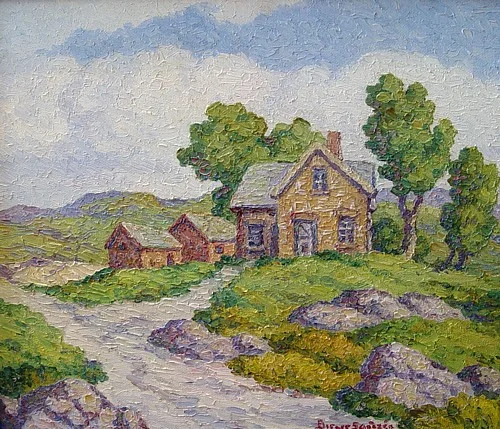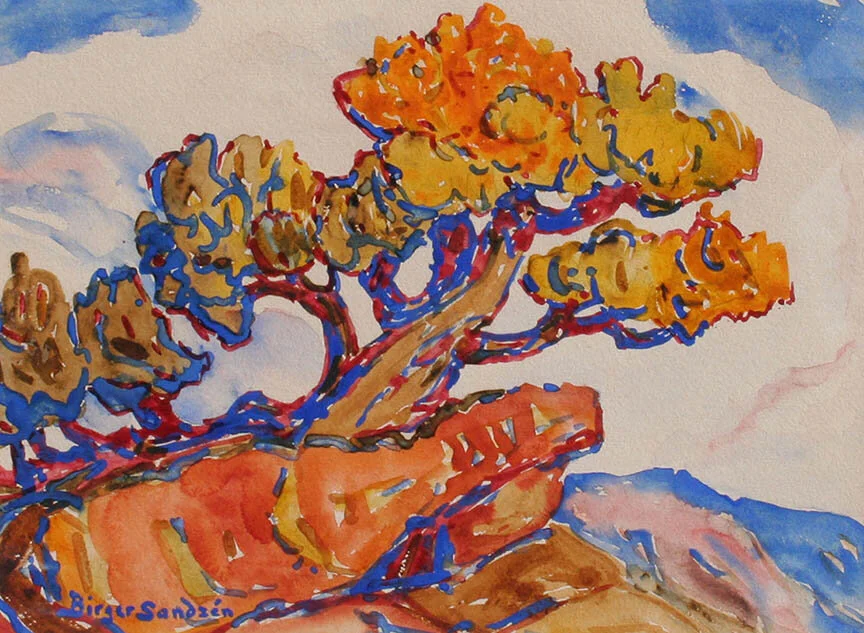Are you interested in selling or consigning your artwork?
Contact us now for a free opinion of value
Birger Sandzen
Birger Sandzen was born in Blidsberg, Sweden in 1871 and spent the majority of his successful career in Lindsborg, Kansas. In Sweden, he studied at the College and Academy of Skara, and at Lund University, one of the oldest universities in Northern Europe, where he took classes in French and Art History. He later attended the technical high school in Stockholm, where he was taught to draw figures and learned the principles of perspective. He studied in Paris before emigrating to Lindsborg in 1894 to teach fine art, art history and French at Bethany College where he remained on the faculty until 1946. He made trips to Santa Fe and Taos, New Mexico beginning in 1918 and, in 1922, exhibited with the Taos Society of Artists in New York.
A man of many diverse talents and interests, Sandzen was very influential in the art community in Kansas, making arrangements for exhibitions and organizing art clubs. He painted murals for several branches of the U.S. Postal service and also worked as a book illustrator. His personal art collection included hundreds of paintings and drawings of the American west. He was also a talented etcher, engraver, and lithographer, producing many editions of scenes from Kansas and Colorado.
He is best known for his colorful, dynamic landscapes featuring mountain lakes and rivers, boulders, aspen trees and rustic buildings. One of the artist's favorite locations was the Smoky Hill River area of central Kansas. In 1916 he visited Colorado, where he was inspired by the natural beauty of the land in the area, particularly the breathtaking settings offered by Rocky Mountain National Park, Estes Park and the Dillon Pinnacles, a group of towering volcanic formations that dominate the Curecanti National Recreation Area's landscape. He also taught some classes at the Broadmoor Hotel, Denver College, and Utah State College. The style and spirit of his works, though uniquely individual, varied throughout his career from Pointillist and Fauvist, to Expressionist and Post-Impressionist. All of this fascinating artist's works throughout his career can certainly be described as dramatic, exciting and vibrant.
Sandzen's prime period is considered to be the 1920's and 1930's, when his works featured especially rich vivid colors with brilliant brushwork. The surface of his paintings during this time emphasize a thick application of paint in a manner reminiscent of Van Gogh or Cezanne. His works showcase his fascination with rich, wonderfully bold color combinations.
Sandzen's mature works in the later part of his career tend toward using a slightly softer and more subdued color palette. The application of paint on the surface, while still energetic and vigorous, is somewhat more restrained. However, even in this later period, Sandzen's hues here are still noticeably brighter and bolder than those seen in the canvases of most of his contemporaries, and his application of paint on the surface continues to be extremely thick and rich with robust brushstrokes. His paintings continued to be vivid, striking, and expressive, as each individual brushstroke undulates and exudes a feeling of movement that perfectly expresses the artist's innate and irrepressible enthusiasm.
Sandzen's work is internationally known and has been exhibited and held in the collections of numerous museums, including the Metropolitan Museum of Art, the Uffizi in Florence, the British Museum, the Denver Art Museum, and the Library of Congress.
For additional information, visit:
Wikipedia
Gustavus Adolphus College - Sandzen and Geology
The Artist’s Network - The American Van Gogh
Deines Cultural Center
Smithsonian American Art Museum


























